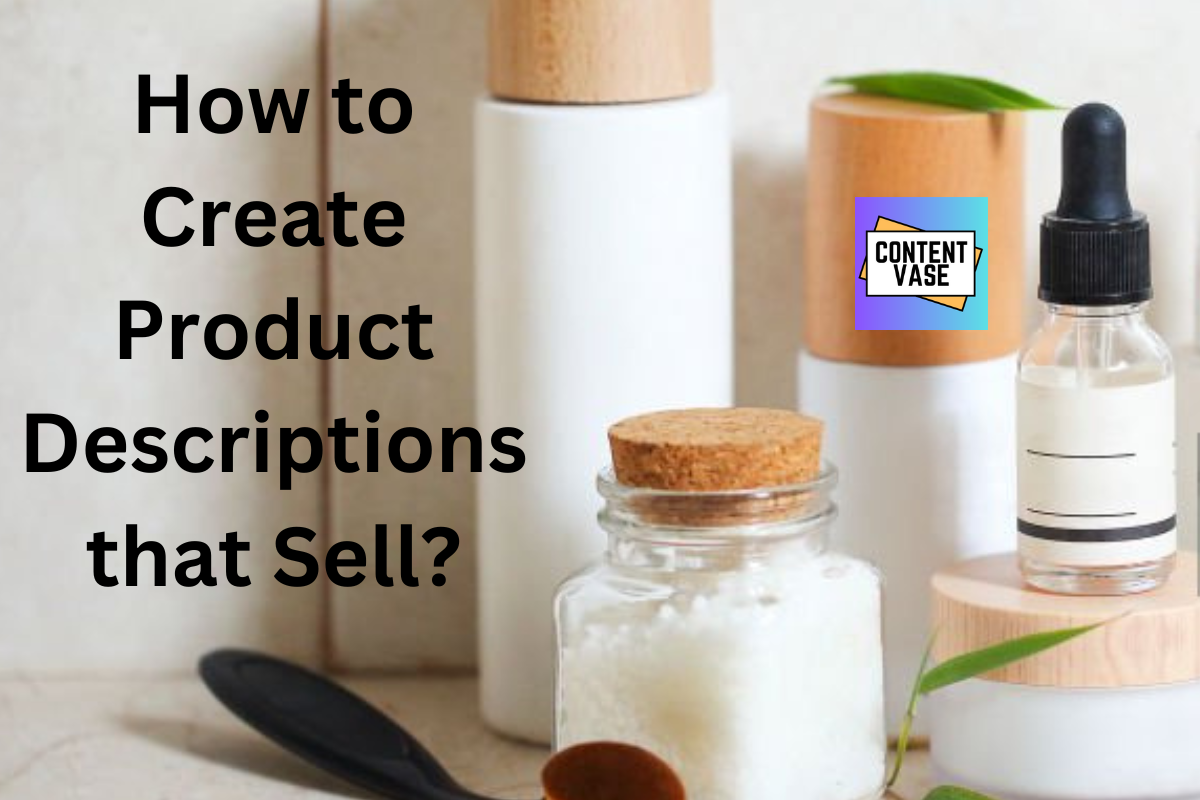How to Create Product Descriptions that Sell?
Creating product descriptions that genuinely help people understand your products at a great level and eventually get sold requires more than a simple list of features and specifications.
How to do that? That’s why you’re here. Keep reading.
Crafting compelling product descriptions involves a balance of storytelling, psychology, and clear communication. If you do it right, a well-written description not only explains the product but also convinces the reader that they need it in their life.
Let’s explore how to create product descriptions that grab your target audience’s attention, have an impact on readers, and drive conversions.
1. Understand Your Target Audience
The foundation of any practical product description writing is knowing who you’re writing for. The tone, language, and information you include will vary greatly depending on whether you’re targeting young adults, busy professionals, parents, or someone else. Start by defining your audience’s profile:
- Who are they? (age, gender, occupation).
- What problems are they looking to solve?
- What are their interests, hobbies, or lifestyles?
When you understand your audience’s needs and preferences, you can create descriptions that speak directly to them, meaning they understand why they require your products. For instance, a high-energy, informal tone might work for a youthful audience, while a professional, informative tone may suit a business-oriented audience.
2. Highlight the Benefits, Not Just the Features
It’s tempting to list features, but a feature-only approach is rarely persuasive. People want to know how your product will improve their lives, solve a problem, or make something more manageable. That’s why you should focus on benefits over features.
- Feature: Comes with an ergonomic handle.
- Benefit: Designed to reduce wrist strain so you can work comfortably for hours.
A good rule of thumb is to list a feature and immediately follow it with the benefit it provides. This way, the customer doesn’t have to figure out why a specific feature is valuable — it’s laid out clearly.
3. Use Engaging, Sensory Language
Dry or overly technical descriptions fail to connect emotionally with potential buyers. Use sensory language that paints a vivid picture and helps customers imagine what it’s like to own and use your product.
Descriptive words that appeal to the senses — like sight, touch, taste, smell, and sound — help create a picture of a product, making it feel more genuine and engaging. For example:
- Sight: Describing color and appearance, like “a deep, rich shade of brown” for a cigar, helps people visualize it.
- Touch: Words that describe texture, like “silky smooth” or “rough and rugged,” help people imagine how it would feel.
- Taste: Flavor words like “earthy and rich” or “a hint of spice” give a sense of the taste experience.
- Smell: Scent descriptions like “smoky aroma” or “hints of cedar and leather” can make someone imagine the smell.
- Sound: Words like “a satisfying snap” or “crisp crackle” bring the sound to life.
Using these sensory words makes the product feel almost natural to readers, even if they’ve never experienced it before.
4. Tell a Story About the Product
Stories create an emotional connection. When people feel a story behind a product, they often perceive it as more valuable or relatable. Think about the origin of the product, what makes it unique, or a problem it solves in an innovative way. Even a brief story can make your product feel like more than just an item on a shelf.
Example: Crafted by a family-owned business that has been perfecting this recipe for over 50 years, our handmade chocolate is as rich in history as it is in flavor.
This approach humanizes the product and connects it to something larger, like tradition, culture, or values.
5. Address Potential Customer Objections
Addressing objections within your product descriptions can reduce hesitation and increase conversions. Think about any doubts a customer might have about your product, such as concerns about quality, durability, size, or usability, and counter these tactically.
Example: Made from durable, eco-friendly materials, this bag is built to bear everyday wear and tear, ensuring it looks as good after years of use as it does today.
This reassurance helps customers feel more confident about making a purchase, as they know you’ve already considered their concerns.
6. Incorporate SEO-Friendly Keywords Naturally
Incorporate relevant keywords to ensure your descriptions are discoverable in search engines. Research the terms people are using to find products like yours and try to incorporate those keywords seamlessly. However, avoid overstuffing keywords, as this can make your text sound forced and reduce readability.
- Instead of:
Phone case stylish, durable phone case for all phone models. - Try: This stylish, durable phone case is crafted for all major phone models, offering both protection and elegance.
The goal is to make it easy for search engines to find your product without compromising the quality and flow of your description.
7. Use Short Paragraphs, Bullet Points, and White Space
Using shorter paragraphs, simple language, and clear headings helps readers follow along. Use bullet points for lists of features or benefits, and include plenty of white space so your description doesn’t feel like a wall of text.
This structure makes it effortless for readers to skip all the descriptions and pick out the information they’re interested in. This way, they feel more engaged with your products, and and the possibility of sales increases.
8. Use Power Words to Persuade and Excite
Power words are terms that evoke strong emotions and can subtly encourage a customer to take action. Words like “exclusive,” “luxurious,” “effortless,” “limited edition,” “proven,” and “guaranteed” can have a big impact on potential customer’s perception.
Example: Upgrade your skincare routine with our exclusive, dermatologist-approved serum. Let it be the top secret for your glowing skin.
Using persuasive words strategically creates excitement and urgency, encouraging customers to buy.
9. Create a Sense of Urgency
Encouraging customers to act faster can help increase sales. By suggesting that a product is in high demand, a limited supply, or available for a short time, you can create a sense of urgency.
When using urgency, make sure it’s genuine. Artificially creating urgency too often can reduce credibility and trust.
10. Use Social Proof and Testimonials
Including social proof within your product descriptions can increase credibility. Brief testimonials, customer reviews, or even references to the number of satisfied customers can make new customers feel more confident in purchasing.
Example: Join over 10,000 happy customers who have made the switch to our eco-friendly packaging. Here’s what one of them had to say: ‘This is the best product I’ve ever used—it’s convenient, sustainable, and looks great!’
Real feedback from other customers helps potential buyers trust your brand and believe in the product’s value.
11. End with a Call to Action (CTA)
Once you’ve captured your reader’s interest, gently nudge them toward taking the next step. A simple CTA like “Add to Cart,” “Buy Now,” or “Experience It for Yourself” can be very effective.
Example: Ready to experience the difference? Add to the cart now and start enjoying the comfort of our eco-friendly pillow today.
A CTA gives direction to readers who are already considering a purchase, subtly pushing them closer to converting.
12. Proofread and Edit for Clarity and Flow
Finally, a well-defined and SEO-optimized product description portrays attention to detail and attracts more visitors. Review your writing for errors, awkward phrasing, or areas that could be clearer. Good grammar and clean formatting help build trust with readers and make the description easy to read.
Minor improvements in clarity and readability can significantly improve your potential customers’ understanding of your products.
Conclusion
Creating product descriptions that sell isn’t about stuffing words on a page — it’s about using terms and phrases to convey value, create desire, and drive action. When you focus on your audience, highlight benefits, and use a friendly, conversational tone, your descriptions will encourage your readers to buy your products.
Need Product Description Service that Maximize Your Sales?
If you are looking for an Amazon product description writer and a product description copywriter for any other eCommerce platform where you sell your products, our professional product description writing service will be of great help. Our skilled product description writers know how to create engaging, persuasive, and SEO-optimized descriptions that capture attention, highlight the unique features of your products, and drive conversions.
Frequently Asked Questions
What should a good product description include?
A good product description should include benefits, a few key features, and sensory details to help customers picture using the product.
What’s the difference between features and benefits in product descriptions?
Features are product details; benefits show how those features improve a customer’s life. Describe both, but focus more on benefits.
How can I write product descriptions that help products sell better?
Understand your audience, highlight benefits, use sensory language, and add a clear call to action. Make it easy for customers to picture owning it.
How do I know who my product descriptions are for?
Think about your ideal customer’s age, interests, and needs. Write descriptions that solve their problems or fit their lifestyle.
Why is SEO (Search Engine Optimization) important in product descriptions?
Using relevant keywords helps people find your products online. Good SEO can drive traffic to your page without affecting readability and eventually increase sales.
How does storytelling help in product descriptions?
Stories create emotional connections and make products feel more valuable, personal, and attractive to potential customers.
What are some tips for writing short and compelling product descriptions?
Use short paragraphs, bullet points, and whitespace. In just a few lines, focus on benefits, sensory language, and a strong call to action.
How can I make my product descriptions SEO-friendly without sounding forced?
Add keywords naturally in the description without stuffing it unnecessarily. Focus on making it sound conversational and valuable to the reader.
What are some powerful words to use in product descriptions?
Words like “exclusive,” “limited edition,” “proven,” and “luxurious” can create excitement and increase customers’ interest in buying.
Why should I add customer testimonials to product descriptions?
Testimonials add credibility, showing potential buyers that others had a good experience, which builds trust and reduces hesitation.
Share this blog on the following social media platforms so that more people can benefit.
Other Blogs



